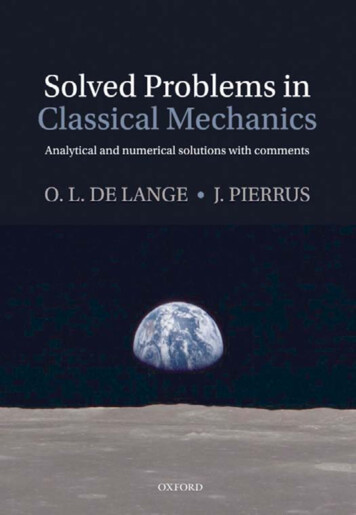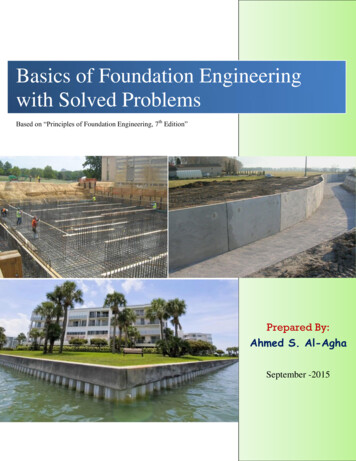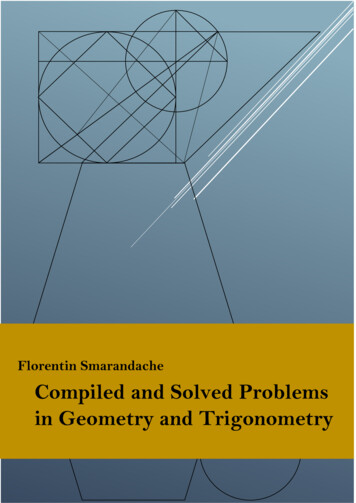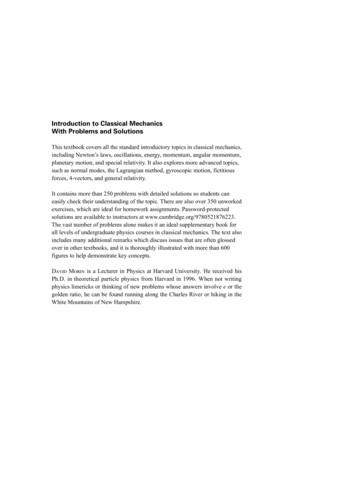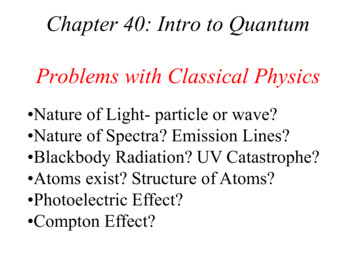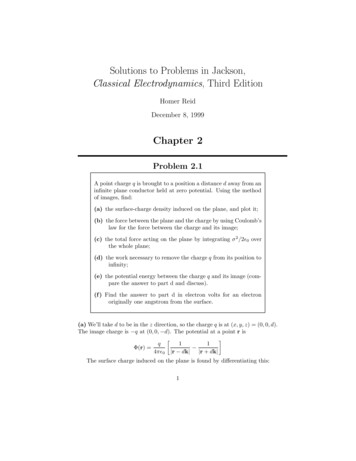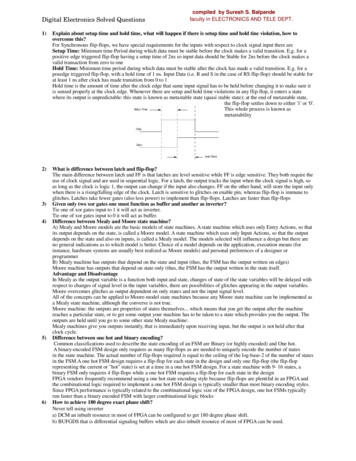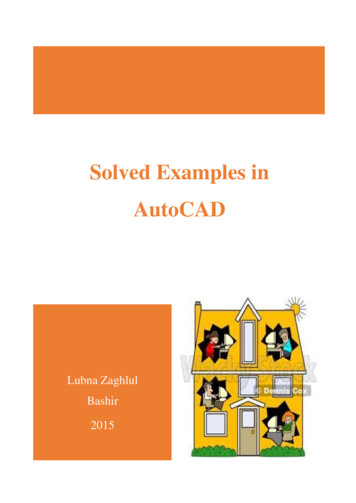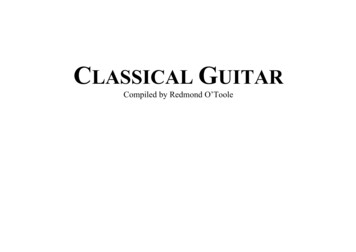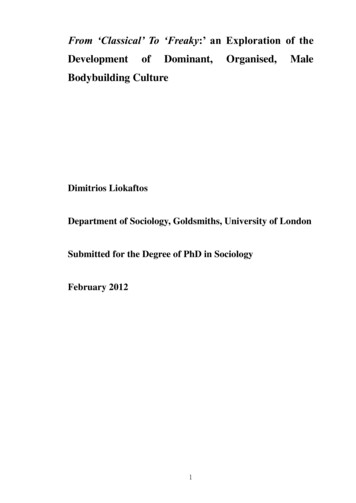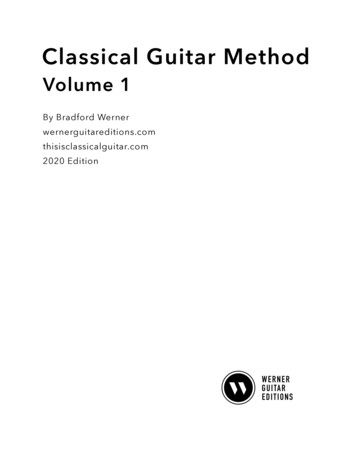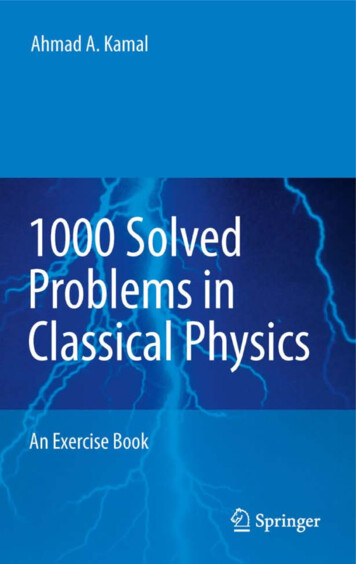
Transcription
1000 Solved Problems in Classical Physics
Ahmad A. Kamal1000 Solved Problemsin Classical PhysicsAn Exercise Book123
Dr. Ahmad A. KamalSilversprings Lane 42575094 Murphy TexasUSAanwarakamal@yahoo.comISBN 978-3-642-11942-2e-ISBN 978-3-642-11943-9DOI 10.1007/978-3-642-11943-9Springer Heidelberg Dordrecht London New York Springer-Verlag Berlin Heidelberg 2011This work is subject to copyright. All rights are reserved, whether the whole or part of the material isconcerned, specifically the rights of translation, reprinting, reuse of illustrations, recitation, broadcasting,reproduction on microfilm or in any other way, and storage in data banks. Duplication of this publicationor parts thereof is permitted only under the provisions of the German Copyright Law of September 9,1965, in its current version, and permission for use must always be obtained from Springer. Violationsare liable to prosecution under the German Copyright Law.The use of general descriptive names, registered names, trademarks, etc. in this publication does notimply, even in the absence of a specific statement, that such names are exempt from the relevant protectivelaws and regulations and therefore free for general use.Cover design: eStudio Calamar S.L.Printed on acid-free paperSpringer is part of Springer Science Business Media (www.springer.com)
Dedicated to my Parents
PrefaceThis book complements the book 1000 Solved Problems in Modern Physics bythe same author and published by Springer-Verlag so that bulk of the courses forundergraduate curriculum are covered. It is targeted mainly at the undergraduatestudents of USA, UK and other European countries and the M.Sc. students of Asiancountries, but will be found useful for the graduate students, students preparingfor graduate record examination (GRE), teachers and tutors. This is a by-productof lectures given at the Osmania University, University of Ottawa and Universityof Tebriz over several years and is intended to assist the students in their assignments and examinations. The book covers a wide spectrum of disciplines in classicalphysics and is mainly based on the actual examination papers of UK and the Indianuniversities. The selected problems display a large variety and conform to syllabiwhich are currently being used in various countries.The book is divided into 15 chapters. Each chapter begins with basic conceptsand a set of formulae used for solving problems for quick reference, followed by anumber of problems and their solutions.The problems are judiciously selected and are arranged section-wise. The solutions are neither pedantic nor terse. The approach is straightforward and step-by-stepsolutions are elaborately provided. There are approximately 450 line diagrams, onefourth of them in colour for illustration. A subject index and a problem index areprovided at the end of the book.Elementary calculus, vector calculus and algebra are the prerequisites. The areasof mechanics and electromagnetism are emphasized. No book on problems canclaim to exhaust the variety in the limited space. An attempt is made to includethe important types of problems at the undergraduate level.It is a pleasure to thank Javid, Suraiya and Techastra Solutions (P) Ltd. fortypesetting and Maryam for her patience. I am grateful to the universities of UK andIndia for permitting me to use their question papers; to R.W. Norris and W. Seymour,Mechanics via Calculus, Longmans, Green and Co., 1923; to Robert A. Becker,Introduction to Theoretical Mechanics, McGraw-Hill Book Co. Inc, 1954, for oneproblem; and Google Images for the cover page. My thanks are to Springer-Verlag,vii
viiiPrefacein particular Claus Ascheron, Adelheid Duhm and Elke Sauer, for constant encouragement.Murphy, TexasNovember 2010Ahmad A. Kamal
Contents1 Kinematics and Statics . . . . . . . . . . . . . . . . . . . . . . . . . . . . . . . . . . . . . . . . . .1.1 Basic Concepts and Formulae . . . . . . . . . . . . . . . . . . . . . . . . . . . . . . .1.2 Problems . . . . . . . . . . . . . . . . . . . . . . . . . . . . . . . . . . . . . . . . . . . . . . . . .1.2.1Motion in One Dimension . . . . . . . . . . . . . . . . . . . . . . . . . . .1.2.2Motion in Resisting Medium . . . . . . . . . . . . . . . . . . . . . . . .1.2.3Motion in Two Dimensions . . . . . . . . . . . . . . . . . . . . . . . . . .1.2.4Force and Torque . . . . . . . . . . . . . . . . . . . . . . . . . . . . . . . . . .1.2.5Centre of Mass . . . . . . . . . . . . . . . . . . . . . . . . . . . . . . . . . . . .1.2.6Equilibrium . . . . . . . . . . . . . . . . . . . . . . . . . . . . . . . . . . . . . . .1.3 Solutions . . . . . . . . . . . . . . . . . . . . . . . . . . . . . . . . . . . . . . . . . . . . . . . . .1.3.1Motion in One Dimension . . . . . . . . . . . . . . . . . . . . . . . . . . .1.3.2Motion in Resisting Medium . . . . . . . . . . . . . . . . . . . . . . . .1.3.3Motion in Two Dimensions . . . . . . . . . . . . . . . . . . . . . . . . . .1.3.4Force and Torque . . . . . . . . . . . . . . . . . . . . . . . . . . . . . . . . . .1.3.5Centre of Mass . . . . . . . . . . . . . . . . . . . . . . . . . . . . . . . . . . . .1.3.6Equilibrium . . . . . . . . . . . . . . . . . . . . . . . . . . . . . . . . . . . . . . .11336691012131321263536442 Particle Dynamics . . . . . . . . . . . . . . . . . . . . . . . . . . . . . . . . . . . . . . . . . . . . . .2.1 Basic Concepts and Formulae . . . . . . . . . . . . . . . . . . . . . . . . . . . . . . .2.2 Problems . . . . . . . . . . . . . . . . . . . . . . . . . . . . . . . . . . . . . . . . . . . . . . . . .2.2.1Motion of Blocks on a Plane . . . . . . . . . . . . . . . . . . . . . . . . .2.2.2Motion on Incline . . . . . . . . . . . . . . . . . . . . . . . . . . . . . . . . . .2.2.3Work, Power, Energy . . . . . . . . . . . . . . . . . . . . . . . . . . . . . . .2.2.4Collisions . . . . . . . . . . . . . . . . . . . . . . . . . . . . . . . . . . . . . . . .2.2.5Variable Mass . . . . . . . . . . . . . . . . . . . . . . . . . . . . . . . . . . . . .2.3 Solutions . . . . . . . . . . . . . . . . . . . . . . . . . . . . . . . . . . . . . . . . . . . . . . . . .2.3.1Motion of Blocks on a Plane . . . . . . . . . . . . . . . . . . . . . . . . .2.3.2Motion on Incline . . . . . . . . . . . . . . . . . . . . . . . . . . . . . . . . . .2.3.3Work, Power, Energy . . . . . . . . . . . . . . . . . . . . . . . . . . . . . . .2.3.4Collisions . . . . . . . . . . . . . . . . . . . . . . . . . . . . . . . . . . . . . . . .2.3.5Variable Mass . . . . . . . . . . . . . . . . . . . . . . . . . . . . . . . . . . . . .4747525253565863646468757795ix
xContents3 Rotational Kinematics . . . . . . . . . . . . . . . . . . . . . . . . . . . . . . . . . . . . . . . . . . 1033.1 Basic Concepts and Formulae . . . . . . . . . . . . . . . . . . . . . . . . . . . . . . . 1033.2 Problems . . . . . . . . . . . . . . . . . . . . . . . . . . . . . . . . . . . . . . . . . . . . . . . . . 1073.2.1Motion in a Horizontal Plane . . . . . . . . . . . . . . . . . . . . . . . . 1073.2.2Motion in a Vertical Plane . . . . . . . . . . . . . . . . . . . . . . . . . . . 1123.2.3Loop-the-Loop . . . . . . . . . . . . . . . . . . . . . . . . . . . . . . . . . . . . 1123.3 Solutions . . . . . . . . . . . . . . . . . . . . . . . . . . . . . . . . . . . . . . . . . . . . . . . . . 1143.3.1Motion in a Horizontal Plane . . . . . . . . . . . . . . . . . . . . . . . . 1143.3.2Motion in a Vertical Plane . . . . . . . . . . . . . . . . . . . . . . . . . . . 1233.3.3Loop-the-Loop . . . . . . . . . . . . . . . . . . . . . . . . . . . . . . . . . . . . 1294 Rotational Dynamics . . . . . . . . . . . . . . . . . . . . . . . . . . . . . . . . . . . . . . . . . . . 1354.1 Basic Concepts and Formulae . . . . . . . . . . . . . . . . . . . . . . . . . . . . . . . 1354.2 Problems . . . . . . . . . . . . . . . . . . . . . . . . . . . . . . . . . . . . . . . . . . . . . . . . . 1384.2.1Moment of Inertia . . . . . . . . . . . . . . . . . . . . . . . . . . . . . . . . . . 1384.2.2Rotational Motion . . . . . . . . . . . . . . . . . . . . . . . . . . . . . . . . . 1394.2.3Coriolis Acceleration . . . . . . . . . . . . . . . . . . . . . . . . . . . . . . . 1494.3 Solutions . . . . . . . . . . . . . . . . . . . . . . . . . . . . . . . . . . . . . . . . . . . . . . . . . 1514.3.1Moment of Inertia . . . . . . . . . . . . . . . . . . . . . . . . . . . . . . . . . . 1514.3.2Rotational Motion . . . . . . . . . . . . . . . . . . . . . . . . . . . . . . . . . 1574.3.3Coriolis Acceleration . . . . . . . . . . . . . . . . . . . . . . . . . . . . . . . 1845 Gravitation . . . . . . . . . . . . . . . . . . . . . . . . . . . . . . . . . . . . . . . . . . . . . . . . . . . . 1895.1 Basic Concepts and Formulae . . . . . . . . . . . . . . . . . . . . . . . . . . . . . . . 1895.2 Problems . . . . . . . . . . . . . . . . . . . . . . . . . . . . . . . . . . . . . . . . . . . . . . . . . 1935.2.1Field and Potential . . . . . . . . . . . . . . . . . . . . . . . . . . . . . . . . . 1935.2.2Rockets and Satellites . . . . . . . . . . . . . . . . . . . . . . . . . . . . . . 1965.3 Solutions . . . . . . . . . . . . . . . . . . . . . . . . . . . . . . . . . . . . . . . . . . . . . . . . . 2015.3.1Field and Potential . . . . . . . . . . . . . . . . . . . . . . . . . . . . . . . . . 2015.3.2Rockets and Satellites . . . . . . . . . . . . . . . . . . . . . . . . . . . . . . 2136 Oscillations . . . . . . . . . . . . . . . . . . . . . . . . . . . . . . . . . . . . . . . . . . . . . . . . . . . . 2356.1 Basic Concepts and Formulae . . . . . . . . . . . . . . . . . . . . . . . . . . . . . . . 2356.2 Problems . . . . . . . . . . . . . . . . . . . . . . . . . . . . . . . . . . . . . . . . . . . . . . . . . 2456.2.1Simple Harmonic Motion (SHM) . . . . . . . . . . . . . . . . . . . . . 2456.2.2Physical Pendulums . . . . . . . . . . . . . . . . . . . . . . . . . . . . . . . . 2486.2.3Coupled Systems of Masses and Springs . . . . . . . . . . . . . . . 2516.2.4Damped Vibrations . . . . . . . . . . . . . . . . . . . . . . . . . . . . . . . . . 2536.3 Solutions . . . . . . . . . . . . . . . . . . . . . . . . . . . . . . . . . . . . . . . . . . . . . . . . . 2546.3.1Simple Harmonic Motion (SHM) . . . . . . . . . . . . . . . . . . . . . 2546.3.2Physical Pendulums . . . . . . . . . . . . . . . . . . . . . . . . . . . . . . . . 2676.3.3Coupled Systems of Masses and Springs . . . . . . . . . . . . . . . 2736.3.4Damped Vibrations . . . . . . . . . . . . . . . . . . . . . . . . . . . . . . . . . 279
Contentsxi7 Lagrangian and Hamiltonian Mechanics . . . . . . . . . . . . . . . . . . . . . . . . . . 2877.1 Basic Concepts and Formulae . . . . . . . . . . . . . . . . . . . . . . . . . . . . . . . 2877.2 Problems . . . . . . . . . . . . . . . . . . . . . . . . . . . . . . . . . . . . . . . . . . . . . . . . . 2887.3 Solutions . . . . . . . . . . . . . . . . . . . . . . . . . . . . . . . . . . . . . . . . . . . . . . . . . 2968 Waves . . . . . . . . . . . . . . . . . . . . . . . . . . . . . . . . . . . . . . . . . . . . . . . . . . . . . . . . . 3398.1 Basic Concepts and Formulae . . . . . . . . . . . . . . . . . . . . . . . . . . . . . . . 3398.2 Problems . . . . . . . . . . . . . . . . . . . . . . . . . . . . . . . . . . . . . . . . . . . . . . . . . 3458.2.1Vibrating Strings . . . . . . . . . . . . . . . . . . . . . . . . . . . . . . . . . . . 3458.2.2Waves in Solids . . . . . . . . . . . . . . . . . . . . . . . . . . . . . . . . . . . . 3508.2.3Waves in Liquids . . . . . . . . . . . . . . . . . . . . . . . . . . . . . . . . . . 3508.2.4Sound Waves . . . . . . . . . . . . . . . . . . . . . . . . . . . . . . . . . . . . . . 3528.2.5Doppler Effect . . . . . . . . . . . . . . . . . . . . . . . . . . . . . . . . . . . . 3548.2.6Shock Wave . . . . . . . . . . . . . . . . . . . . . . . . . . . . . . . . . . . . . . . 3558.2.7Reverberation . . . . . . . . . . . . . . . . . . . . . . . . . . . . . . . . . . . . . 3558.2.8Echo . . . . . . . . . . . . . . . . . . . . . . . . . . . . . . . . . . . . . . . . . . . . . 3558.2.9Beat Frequency . . . . . . . . . . . . . . . . . . . . . . . . . . . . . . . . . . . . 3558.2.10 Waves in Pipes . . . . . . . . . . . . . . . . . . . . . . . . . . . . . . . . . . . . 3568.3 Solutions . . . . . . . . . . . . . . . . . . . . . . . . . . . . . . . . . . . . . . . . . . . . . . . . . 3568.3.1Vibrating Strings . . . . . . . . . . . . . . . . . . . . . . . . . . . . . . . . . . . 3568.3.2Waves in Solids . . . . . . . . . . . . . . . . . . . . . . . . . . . . . . . . . . . . 3718.3.3Waves in Liquids . . . . . . . . . . . . . . . . . . . . . . . . . . . . . . . . . . 3738.3.4Sound Waves . . . . . . . . . . . . . . . . . . . . . . . . . . . . . . . . . . . . . . 3788.3.5Doppler Effect . . . . . . . . . . . . . . . . . . . . . . . . . . . . . . . . . . . . 3848.3.6Shock Wave . . . . . . . . . . . . . . . . . . . . . . . . . . . . . . . . . . . . . . . 3868.3.7Reverberation . . . . . . . . . . . . . . . . . . . . . . . . . . . . . . . . . . . . . 3868.3.8Echo . . . . . . . . . . . . . . . . . . . . . . . . . . . . . . . . . . . . . . . . . . . . . 3878.3.9Beat Frequency . . . . . . . . . . . . . . . . . . . . . . . . . . . . . . . . . . . . 3888.3.10 Waves in Pipes . . . . . . . . . . . . . . . . . . . . . . . . . . . . . . . . . . . . 3899 Fluid Dynamics . . . . . . . . . . . . . . . . . . . . . . . . . . . . . . . . . . . . . . . . . . . . . . . . 3919.1 Basic Concepts and Formulae . . . . . . . . . . . . . . . . . . . . . . . . . . . . . . . 3919.2 Problems . . . . . . . . . . . . . . . . . . . . . . . . . . . . . . . . . . . . . . . . . . . . . . . . . 3949.2.1Bernoulli’s Equation . . . . . . . . . . . . . . . . . . . . . . . . . . . . . . . 3949.2.2Torricelli’s Theorem . . . . . . . . . . . . . . . . . . . . . . . . . . . . . . . . 3969.2.3Viscosity . . . . . . . . . . . . . . . . . . . . . . . . . . . . . . . . . . . . . . . . . 3979.3 Solutions . . . . . . . . . . . . . . . . . . . . . . . . . . . . . . . . . . . . . . . . . . . . . . . . . 3989.3.1Bernoulli’s Equation . . . . . . . . . . . . . . . . . . . . . . . . . . . . . . . 3989.3.2Torricelli’s Theorem . . . . . . . . . . . . . . . . . . . . . . . . . . . . . . . . 4039.3.3Viscosity . . . . . . . . . . . . . . . . . . . . . . . . . . . . . . . . . . . . . . . . . 40610 Heat and Matter . . . . . . . . . . . . . . . . . . . . . . . . . . . . . . . . . . . . . . . . . . . . . . . 40910.1 Basic Concepts and Formulae . . . . . . . . . . . . . . . . . . . . . . . . . . . . . . . 40910.2 Problems . . . . . . . . . . . . . . . . . . . . . . . . . . . . . . . . . . . . . . . . . . . . . . . . . 414
xiiContents10.2.1 Kinetic Theory of Gases . . . . . . . . . . . . . . . . . . . . . . . . . . . . 41410.2.2 Thermal Expansion . . . . . . . . . . . . . . . . . . . . . . . . . . . . . . . . 41610.2.3 Heat Transfer . . . . . . . . . . . . . . . . . . . . . . . . . . . . . . . . . . . . . 41810.2.4 Specific Heat and Latent Heat . . . . . . . . . . . . . . . . . . . . . . . . 42010.2.5 Thermodynamics . . . . . . . . . . . . . . . . . . . . . . . . . . . . . . . . . . 42010.2.6 Elasticity . . . . . . . . . . . . . . . . . . . . . . . . . . . . . . . . . . . . . . . . . 42310.2.7 Surface Tension . . . . . . . . . . . . . . . . . . . . . . . . . . . . . . . . . . . 42510.3 Solutions . . . . . . . . . . . . . . . . . . . . . . . . . . . . . . . . . . . . . . . . . . . . . . . . . 42510.3.1 Kinetic Theory of Gases . . . . . . . . . . . . . . . . . . . . . . . . . . . . 42510.3.2 Thermal Expansion . . . . . . . . . . . . . . . . . . . . . . . . . . . . . . . . 43010.3.3 Heat Transfer . . . . . . . . . . . . . . . . . . . . . . . . . . . . . . . . . . . . . 43310.3.4 Specific Heat and Latent Heat . . . . . . . . . . . . . . . . . . . . . . . . 43910.3.5 Thermodynamics . . . . . . . . . . . . . . . . . . . . . . . . . . . . . . . . . . 44110.3.6 Elasticity . . . . . . . . . . . . . . . . . . . . . . . . . . . . . . . . . . . . . . . . . 45210.3.7 Surface Tension . . . . . . . . . . . . . . . . . . . . . . . . . . . . . . . . . . . 45511 Electrostatics . . . . . . . . . . . . . . . . . . . . . . . . . . . . . . . . . . . . . . . . . . . . . . . . . . 45911.1 Basic Concepts and Formulae . . . . . . . . . . . . . . . . . . . . . . . . . . . . . . . 45911.2 Problems . . . . . . . . . . . . . . . . . . . . . . . . . . . . . . . . . . . . . . . . . . . . . . . . . 46511.2.1 Electric Field and Potential . . . . . . . . . . . . . . . . . . . . . . . . . . 46511.2.2 Gauss’ Law . . . . . . . . . . . . . . . . . . . . . . . . . . . . . . . . . . . . . . . 47311.2.3 Capacitors . . . . . . . . . . . . . . . . . . . . . . . . . . . . . . . . . . . . . . . . 47611.3 Solutions . . . . . . . . . . . . . . . . . . . . . . . . . . . . . . . . . . . . . . . . . . . . . . . . . 48211.3.1 Electric Field and Potential . . . . . . . . . . . . . . . . . . . . . . . . . . 48211.3.2 Gauss’ Law . . . . . . . . . . . . . . . . . . . . . . . . . . . . . . . . . . . . . . . 50611.3.3 Capacitors . . . . . . . . . . . . . . . . . . . . . . . . . . . . . . . . . . . . . . . . 51712 Electric Circuits . . . . . . . . . . . . . . . . . . . . . . . . . . . . . . . . . . . . . . . . . . . . . . . 53512.1 Basic Concepts and Formulae . . . . . . . . . . . . . . . . . . . . . . . . . . . . . . . 53512.2 Problems . . . . . . . . . . . . . . . . . . . . . . . . . . . . . . . . . . . . . . . . . . . . . . . . . 53812.2.1 Resistance, EMF, Current, Power . . . . . . . . . . . . . . . . . . . . . 53812.2.2 Cells . . . . . . . . . . . . . . . . . . . . . . . . . . . . . . . . . . . . . . . . . . . . . 54412.2.3 Instruments . . . . . . . . . . . . . . . . . . . . . . . . . . . . . . . . . . . . . . . 54412.2.4 Kirchhoff’s Laws . . . . . . . . . . . . . . . . . . . . . . . . . . . . . . . . . . 54712.3 Solutions . . . . . . . . . . . . . . . . . . . . . . . . . . . . . . . . . . . . . . . . . . . . . . . . . 55212.3.1 Resistance, EMF, Current, Power . . . . . . . . . . . . . . . . . . . . . 55212.3.2 Cells . . . . . . . . . . . . . . . . . . . . . . . . . . . . . . . . . . . . . . . . . . . . . 56212.3.3 Instruments . . . . . . . . . . . . . . . . . . . . . . . . . . . . . . . . . . . . . . . 56412.3.4 Kirchhoff’s Laws . . . . . . . . . . . . . . . . . . . . . . . . . . . . . . . . . . 56913 Electromagnetism I . . . . . . . . . . . . . . . . . . . . . . . . . . . . . . . . . . . . . . . . . . . . 57913.1 Basic Concepts and Formulae . . . . . . . . . . . . . . . . . . . . . . . . . . . . . . . 57913.2 Problems . . . . . . . . . . . . . . . . . . . . . . . . . . . . . . . . . . . . . . . . . . . . . . . . . 583
Contentsxiii13.2.1Motion of Charged Particles in Electricand Magnetic Fields . . . . . . . . . . . . . . . . . . . . . . . . . . . . . . . 58313.2.2 Magnetic Induction . . . . . . . . . . . . . . . . . . . . . . . . . . . . . . . . 58713.2.3 Magnetic Force . . . . . . . . . . . . . . . . . . . . . . . . . . . . . . . . . . . . 59313.2.4 Magnetic Energy, Magnetic Dipole Moment . . . . . . . . . . . . 59513.2.5 Faraday’s Law . . . . . . . . . . . . . . . . . . . . . . . . . . . . . . . . . . . . . 59613.2.6 Hall Effect . . . . . . . . . . . . . . . . . . . . . . . . . . . . . . . . . . . . . . . . 59913.3 Solutions . . . . . . . . . . . . . . . . . . . . . . . . . . . . . . . . . . . . . . . . . . . . . . . . . 59913.3.1 Motion of Charged Particles in Electricand Magnetic Fields . . . . . . . . . . . . . . . . . . . . . . . . . . . . . . . 59913.3.2 Magnetic Induction . . . . . . . . . . . . . . . . . . . . . . . . . . . . . . . . 60613.3.3 Magnetic Force . . . . . . . . . . . . . . . . . . . . . . . . . . . . . . . . . . . . 61913.3.4 Magnetic Energy, Magnetic Dipole Moment . . . . . . . . . . . . 62213.3.5 Faraday’s Law . . . . . . . . . . . . . . . . . . . . . . . . . . . . . . . . . . . . . 62513.3.6 Hall Effect . . . . . . . . . . . . . . . . . . . . . . . . . . . . . . . . . . . . . . . . 62914 Electromagnetism II . . . . . . . . . . . . . . . . . . . . . . . . . . . . . . . . . . . . . . . . . . . . 63114.1 Basic Concepts and Formulae . . . . . . . . . . . . . . . . . . . . . . . . . . . . . . . 63114.2 Problems . . . . . . . . . . . . . . . . . . . . . . . . . . . . . . . . . . . . . . . . . . . . . . . . . 63714.2.1 The RLC Circuits . . . . . . . . . . . . . . . . . . . . . . . . . . . . . . . . . . 63714.2.2 Maxwell’s Equations, Electromagnetic Waves,Poynting Vector . . . . . . . . . . . . . . . . . . . . . . . . . . . . . . . . . . . 64214.2.3 Phase Velocity and Group Velocity . . . . . . . . . . . . . . . . . . . 64914.2.4 Waveguides . . . . . . . . . . . . . . . . . . . . . . . . . . . . . . . . . . . . . . . 65014.3 Solutions . . . . . . . . . . . . . . . . . . . . . . . . . . . . . . . . . . . . . . . . . . . . . . . . . 65114.3.1 The RLC Circuits . . . . . . . . . . . . . . . . . . . . . . . . . . . . . . . . . . 65114.3.2 Maxwell’s Equations and Electromagnetic Waves,Poynting Vector . . . . . . . . . . . . . . . . . . . . . . . . . . . . . . . . . . . 66514.3.3 Phase Velocity and Group Velocity . . . . . . . . . . . . . . . . . . . 69214.3.4 Waveguides . . . . . . . . . . . . . . . . . . . . . . . . . . . . . . . . . . . . . . . 69615 Optics . . . . . . . . . . . . . . . . . . . . . . . . . . . . . . . . . . . . . . . . . . . . . . . . . . . . . . . . 70315.1 Basic Concepts and Formulae . . . . . . . . . . . . . . . . . . . . . . . . . . . . . . . 70315.2 Problems . . . . . . . . . . . . . . . . . . . . . . . . . . . . . . . . . . . . . . . . . . . . . . . . . 71315.2.1 Geometrical Optics . . . . . . . . . . . . . . . . . . . . . . . . . . . . . . . . . 71315.2.2 Prisms and Lenses . . . . . . . . . . . . . . . . . . . . . . . . . . . . . . . . . 71515.2.3 Matrix Methods . . . . . . . . . . . . . . . . . . . . . . . . . . . . . . . . . . . 71715.2.4 Interference . . . . . . . . . . . . . . . . . . . . . . . . . . . . . . . . . . . . . . . 71715.2.5 Diffraction . . . . . . . . . . . . . . . . . . . . . . . . . . . . . . . . . . . . . . . . 72115.2.6 Polarization . . . . . . . . . . . . . . . . . . . . . . . . . . . . . . . . . . . . . . . 72415.3 Solutions . . . . . . . . . . . . . . . . . . . . . . . . . . . . . . . . . . . . . . . . . . . . . . . . . 72515.3.1 Geometrical Optics . . . . . . . . . . . . . . . . . . . . . . . . . . . . . . . . . 72515.3.2 Prisms and Lenses . . . . . . . . . . . . . . . . . . . . . . . . . . . . . . . . . 72815.3.3 Matrix Methods . . . . . . . . . . . . . . . . . . . . . . . . . . . . . . . . . . . 737
xivContents15.3.415.3.515.3.6Interference . . . . . . . . . . . . . . . . . . . . . . . . . . . . . . . . . . . . . . . 740Diffraction . . . . . . . . . . . . . . . . . . . . . . . . . . . . . . . . . . . . . . . . 751Polarization . . . . . . . . . . . . . . . . . . . . . . . . . . . . . . . . . . . . . . . 760Subject Index . . . . . . . . . . . . . . . . . . . . . . . . . . . . . . . . . . . . . . . . . . . . . . . . . . . . . . 765Problem Index . . . . . . . . . . . . . . . . . . . . . . . . . . . . . . . . . . . . . . . . . . . . . . . . . . . . . 769
Chapter 1Kinematics and StaticsAbstract Chapter 1 is devoted to problems based on one and two dimensions.The use of various kinematical formulae and the sign convention are pointed out.Problems in statics involve force and torque, centre of mass of various systems andequilibrium.1.1 Basic Concepts and FormulaeMotion in One DimensionThe notation used is as follows: u initial velocity, v final velocity, a acceleration, s displacement, t time (Table 1.1).Table 1.1 Kinematical equationsUVA(i)(ii)(iii)(iv)v u ats ut 1/2at 2v 2 u 2 2ass 12 (u v)t X XStX X In each of the equations u is present. Out of the remaining four quantities onlythree are required. The initial direction of motion is taken as positive. Along thisdirection u and s and a are taken as positive, t is always positive, v can be positiveor negative. As an example, an object is dropped from a rising balloon. Here, theparameters for the object will be as follows:u initial velocity of the balloon (as seen from the ground)u ve, a g. t ve, v ve or ve depending on the value of t, s veor ve, if s ve, then the object is found below the point it was released.Note that (ii) and (iii) are quadratic. Depending on the value of u, both theroots may be real or only one may be real or both may be imaginary and thereforeunphysical.1
21 Kinematics and Staticsv–t and a–t GraphsThe area under the v–t graph gives the displacement (see prob. 1.11) and the areaunder the a–t graph gives the velocity.Motion in Two Dimensions – Projectile MotionEquation: y x tan α 1 gx 22 u 2 cos2 α(1.1)Fig. 1.1 Projectile MotionTime of flight: T Range: R 2u sin αgu 2 sin 2αg(1.4)g 2 t 2 2ug sin α.t u 2(1.5)u sin α gtu cos α(1.6) Angle: tan θ (1.3)u 2 sin2 α2gMaximum height: H Velocity: v (1.2)Relative VelocityIf vA is the velocity of A and vB that of B, then the relative velocity of A with respectto B will bevAB vA vB(1.7)Motion in Resisting MediumIn the absence of air the initial speed of a particle thrown upward is equal to thatof final speed, and the time of ascent is equal to that of descent. However, in thepresence of air resistance the final speed is less than the initial speed and the time ofdescent is greater than that of ascent (see prob. 1.21).
1.2Problems3Equation of motion of a body in air whose resistance varies as the velocity of thebody (see prob. 1.22).Centre of mass is defined asr cm m i ri1 m i r i m iM(1.8)Centre of mass velocity is defined asVc 1 m i ṙiM(1.9)The centre of mass moves as if the mass of various particles is concentrated atthe location of the centre of mass.EquilibriumA system will be in translational equilibrium if F 0. In terms of potential V 2V 0. 0, where V is the potential. The equilibrium will be stable if x x2A system will be in rotational equilibrium if the sum of the external torques is zero,i.e. τi 01.2 Problems1.2.1 Motion in One Dimension1.1 A car starts from rest at constant acceleration of 2.0 m/s2 . At the same instanta truck travelling with a constant speed of 10 m/s overtakes and passes the car.(a) How far beyond the starting point will the car overtake the truck?(b) After what time will this happen?(c) At that instant what will be the speed of the car?1.2 From an elevated point A, a stone is projected vertically upward. When thestone reaches a distance h below A, its velocity is double of what it was at aheight h above A. Show that the greatest height obtained by the stone above Ais 5h/3.[Adelaide University]1.3 A stone is dropped from a height of 19.6 m, above the ground while a secondstone is simultaneously projected from the ground with sufficient velocity toenable it to ascend 19.6 m. When and where the stones would meet.1.4 A particle moves according to the law x A sin π t, where x is the displacement and t is time. Find the distance traversed by the particle in 3.0 s.
41 Kinematics and Statics1.5 A man of height 1.8 m walks away from a lamp at a height of 6 m. If the man’sspeed is 7 m/s, find the speed in m/s at which the tip of the shadow moves. 1.6 The relation 3t 3x 6 describes the displacement of a particle in onedirection, where x is in metres and t in seconds. Find the displacement whenthe velocity is zero.1.7 A particle projected up passes the same height h at 2 and 10 s. Find h if g 9.8 m/s2 .1.8 Cars A and B are travelling in adjacent lanes along a straight road (Fig. 1.2).At time, t 0 their positions and speeds are as shown in the diagram. If car Ahas a constant acceleration of 0.6 m/s2 and car B has a constant deceleration of0.46 m/s2 , determine when A will overtake B.[University of Manchester 2007]Fig. 1.21.9 A boy stands at A in a field at a distance 600 m from the road BC. In the fieldhe can walk at 1 m/s while on the road at 2 m/s. He can walk in the field alongAD and on the road along DC so as to reach the destination C (Fig. 1.3). Whatshould be his route so that he can reach the destination in the least time anddetermine the time.Fig. 1.31.10 Water drips from the nozzle of a shower onto the floor 2.45 m below. The dropsfall at regular interval of time, the first drop striking the floor at the instant thethird drop begins to fall. Locate the second drop when the first drop strikes thefloor.1.11 The velocity–time graph for the vertical component of the velocity of an objectthrown upward from the ground which reaches the roof of a building andreturns to the ground is shown in Fig. 1.4. Calculate the height of the building.
1.2Problems5Fig. 1.41.12 A ball is dropped into a lake from a diving board 4.9 m above the water. Ithits the water with velocity v and then sinks to the bottom with the constantvelocity v. It reaches the bottom of the lake 5.0 s after it is dropped. Find(a) the average velocity of the ball and(b) the depth of the lake.1.13 A stone is dropped into the water from a tower 44.1 m above the ground.Another stone is thrown vertically down 1.0 s after the first one is dropped.Both the stones strike the ground at the same time. What was the initial velocity of the second stone?1.14 A boy observes a cricket ball move up and down past a window 2 m high. Ifthe total time the ball is in sight is 1.0 s, find the height above the window thatthe ball rises.1.15 In the last second of a free fall, a body covered three-fourth of its total path:(a) For what time did the body fall?(b) From what height did the body fall?1.16 A man travelling west at 4 km/h finds that the wind appears to blow fromthe south. On doubling his speed he finds that it appears to blow from thesouthwest. Find the magnitude and direction of the wind’s velocity.1.17 An elevator of height h ascends with constant acceleration a. When it crossesa platform, it has
1000 Solved Problems in Classical Physics An Exercise Book 123. Dr. Ahmad A. Kamal Silversprings Lane 425 75094 Murphy Texas USA anwarakamal@yahoo.com ISBN 978-3-642-11942-2 e-ISBN 978-3-642-11943-9 DOI 10.1007/978-3-
